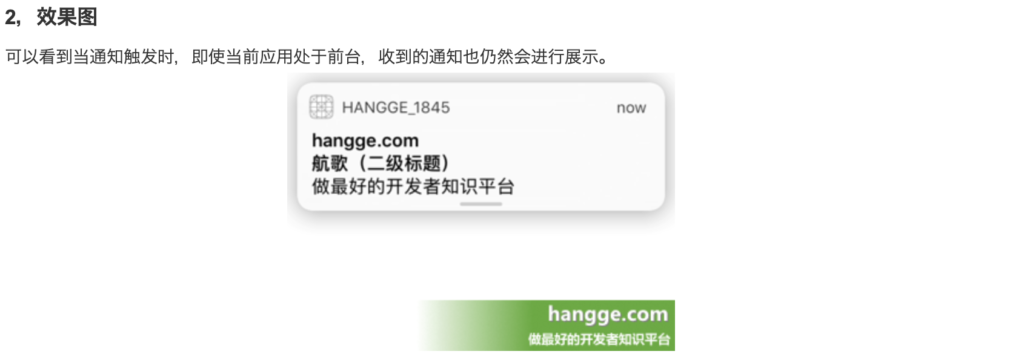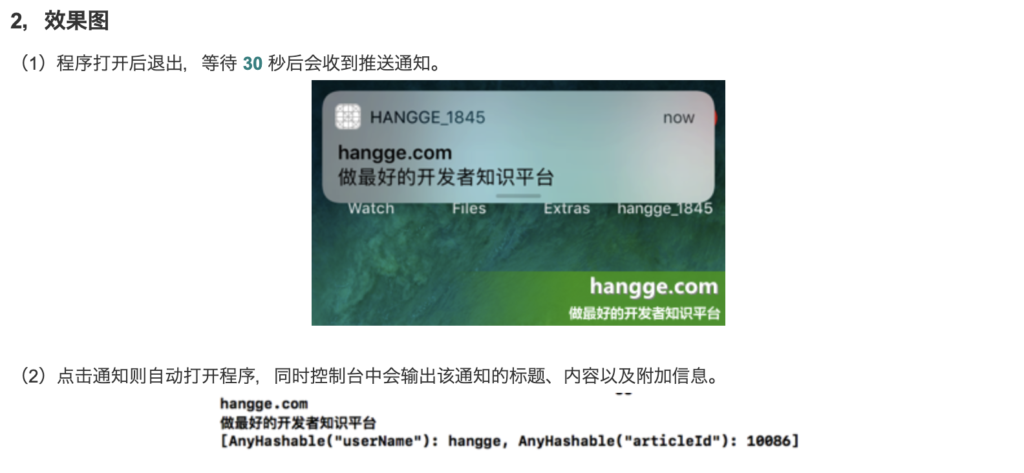UNUserNotificationCenter.current().getPendingNotificationRequests { (requests) in
//遍历所有未推送的request
for request in requests {
print(request)
}
}
UNUserNotificationCenter.current().getDeliveredNotifications { (notifications) in
//遍历所有已推送的通知
for notification in notifications {
print(notification)
}
}
//使用同样的请求标识符来设置一个新的通知
let requestIdentifier = "com.hangge.testNotification"
let request = UNNotificationRequest(identifier: requestIdentifier,
content: content, trigger: trigger)
//将通知请求添加到发送中心
UNUserNotificationCenter.current().add(request) { error in
if error == nil {
print("Time Interval Notification scheduled: \(requestIdentifier)")
}
}
//根据identifier来取消指定通知
let identifier = "com.hangge.testNotification"
UNUserNotificationCenter.current().removePendingNotificationRequests(withIdentifiers: [identifier])
//取消全部未发送通知
UNUserNotificationCenter.current().removeAllPendingNotificationRequests()
//根据identifier来删除指定通知
let identifier = "com.hangge.testNotification"
UNUserNotificationCenter.current().removeDeliveredNotifications(withIdentifiers: [identifier])
//删除全部已发送通知
UNUserNotificationCenter.current().removeAllDeliveredNotifications()
import UIKit
import UserNotifications
@UIApplicationMain
class AppDelegate: UIResponder, UIApplicationDelegate {
var window: UIWindow?
let notificationHandler = NotificationHandler()
func application(_ application: UIApplication, didFinishLaunchingWithOptions
launchOptions: [UIApplicationLaunchOptionsKey: Any]?) -> Bool {
//请求通知权限
UNUserNotificationCenter.current()
.requestAuthorization(options: [.alert, .sound, .badge]) {
(accepted, error) in
if !accepted {
print("用户不允许消息通知。")
}
}
//设置通知代理
UNUserNotificationCenter.current().delegate = notificationHandler
return true
}
func applicationWillResignActive(_ application: UIApplication) {
}
func applicationDidEnterBackground(_ application: UIApplication) {
}
func applicationWillEnterForeground(_ application: UIApplication) {
}
func applicationDidBecomeActive(_ application: UIApplication) {
}
func applicationWillTerminate(_ application: UIApplication) {
}
}
class NotificationHandler: NSObject, UNUserNotificationCenterDelegate {
//在应用内展示通知
func userNotificationCenter(_ center: UNUserNotificationCenter,
willPresent notification: UNNotification,
withCompletionHandler completionHandler:
@escaping (UNNotificationPresentationOptions) -> Void) {
completionHandler([.alert, .sound])
// 如果不想显示某个通知,可以直接用空 options 调用 completionHandler:
// completionHandler([])
}
}
import UIKit
import UserNotifications
class ViewController: UIViewController {
override func viewDidLoad() {
super.viewDidLoad()
//设置推送内容
let content = UNMutableNotificationContent()
content.title = "hangge.com"
content.body = "做最好的开发者知识平台"
content.userInfo = ["userName": "hangge", "articleId": 10086]
//设置通知触发器
let trigger = UNTimeIntervalNotificationTrigger(timeInterval: 30, repeats: false)
//设置请求标识符
let requestIdentifier = "com.hangge.testNotification"
//设置一个通知请求
let request = UNNotificationRequest(identifier: requestIdentifier,
content: content, trigger: trigger)
//将通知请求添加到发送中心
UNUserNotificationCenter.current().add(request) { error in
if error == nil {
print("Time Interval Notification scheduled: \(requestIdentifier)")
}
}
}
override func didReceiveMemoryWarning() {
super.didReceiveMemoryWarning()
}
}
import UIKit
import UserNotifications
@UIApplicationMain
class AppDelegate: UIResponder, UIApplicationDelegate {
var window: UIWindow?
let notificationHandler = NotificationHandler()
func application(_ application: UIApplication, didFinishLaunchingWithOptions
launchOptions: [UIApplicationLaunchOptionsKey: Any]?) -> Bool {
//请求通知权限
UNUserNotificationCenter.current()
.requestAuthorization(options: [.alert, .sound, .badge]) {
(accepted, error) in
if !accepted {
print("用户不允许消息通知。")
}
}
//设置通知代理
UNUserNotificationCenter.current().delegate = notificationHandler
return true
}
func applicationWillResignActive(_ application: UIApplication) {
}
func applicationDidEnterBackground(_ application: UIApplication) {
}
func applicationWillEnterForeground(_ application: UIApplication) {
}
func applicationDidBecomeActive(_ application: UIApplication) {
}
func applicationWillTerminate(_ application: UIApplication) {
}
}
class NotificationHandler: NSObject, UNUserNotificationCenterDelegate {
//对通知进行响应(用户与通知进行交互时被调用)
func userNotificationCenter(_ center: UNUserNotificationCenter,
didReceive response: UNNotificationResponse,
withCompletionHandler completionHandler:
@escaping () -> Void) {
print(response.notification.request.content.title)
print(response.notification.request.content.body)
//获取通知附加数据
let userInfo = response.notification.request.content.userInfo
print(userInfo)
//完成了工作
completionHandler()
}
}











